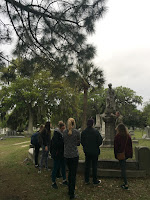The tour was from Bulldog Tours and our tour guide's name was Randy Johnson.
The jail opened its doors in 1802 and closed in 1939. "During that time, it is said that around 14000 people have died there" Johnson stated. With that information, you can assume that many people who were sent here never left. "One of the biggest killers inside the church was the yellow fever and often killed over a hundred people in just a month" Johnson stated.
The jail often suffered from overcrowding and the conditions were very poorly often with many sick people and not receiving proper care, dirty drinking water, and open floors that would leak excrements onto the occupants below. Along the walls you can see graffiti that the prisoners left. Despite what they did to end up there, you cannot help but feel sorry for them. Cages were pretty much in every room that held the prisoners, similar to cages where animals were kept. The cages where the insane prisoners were kept only gave them enough room to stand. They were kept like this for weeks at a time and many of them died. Once the jail was shut down, people were unsure of what to do with it so it fell into disrepair and was finally converted into what it is today: a popular tourist destination and one of the most haunted places in the United States.
Overall, the tour was really fun despite me being pretty scared. I got to learn a lot of history about the jail and of Charleston. I definitely would like to go back on another tour. Later that night when I was flipping through the pictures I took, I think I even captured a picture of a ghost. What do you think? Middle picture, Botton left window, and all the way to the left.
 |
| Outside view of the jail |
 |
| Can you find the ghost? |
 |
| Hallway of the 2nd floor |







